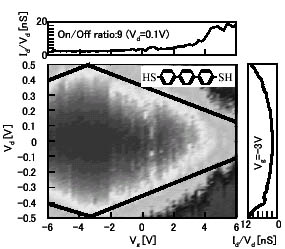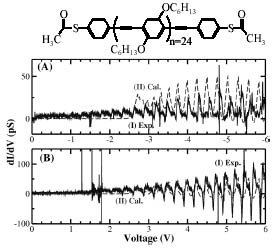Touichiro Goto and Yoshiaki Kashimura
Materials Science Laboratory
Molecular devices with a few molecules have attracted considerable attention as next generation electronic devices because of their high-density and low-power nature. The characteristics of molecular devices can be tuned by controlling molecules. However, there have only been a few reports about molecular devices operating at room temperature. In addition, the instability of the junctions between electrodes and molecules has prevented research on the characteristics of molecular devices.
In this study, we fabricated gold nanogap electrode devices with conjugated molecules. Conjugated molecules have a functional group at each end, which selectively chemisorbs to gold. First, we measured the electronic properties of molecular devices with terphenyldithiol (TPDT), which is 1.5 nm long. We observed a Coulomb diamond, i.e. the single-electron charging effect, at room temperature [Fig. 1]. A simulation based on single-electron circuits showed that the device characteristics can be explained on the basis of a multi-metallic-island system. We consider that gold islands between the electrodes work as single-electron islands, and TPDT bridging metallic islands and the electrodes work as tunnel junctions [1](In cooperation with Nanodevices Research Group).
Next, we synthesized rigid conjugated polymer poly(p-phenylene-ethynylene)s (PPEs) with thioacetyl end groups (TA-PPE). TA-PPE
self assembled in the gold nanogap electrodes (18-nm gap) and we measured
its electronic properties. The room temperature current-voltage (conductance-voltage)
characteristics exhibited periodic, repeatable, and identical stepwise
features [Fig. 2]. First-principle calculations based on the resonant tunneling
effect suggest that the equidistant steps result from the opening of different
conducting channels that correspond to the unoccupied molecular orbitals
of TA-PPE [2].
It is intriguing that molecular devices show Coulomb diamond and quantized electronic structures at room temperature. As the next stage, we will study the characteristics of biomolecules in nanodevices.
[1] T. Goto et al., Jpn. J. Appl. Phys. 45 (2006) 4285.
[2] W. Hu et al., Phys. Rev. Lett. 96 (2006) 027801.
 |
 |
|||||
|
|